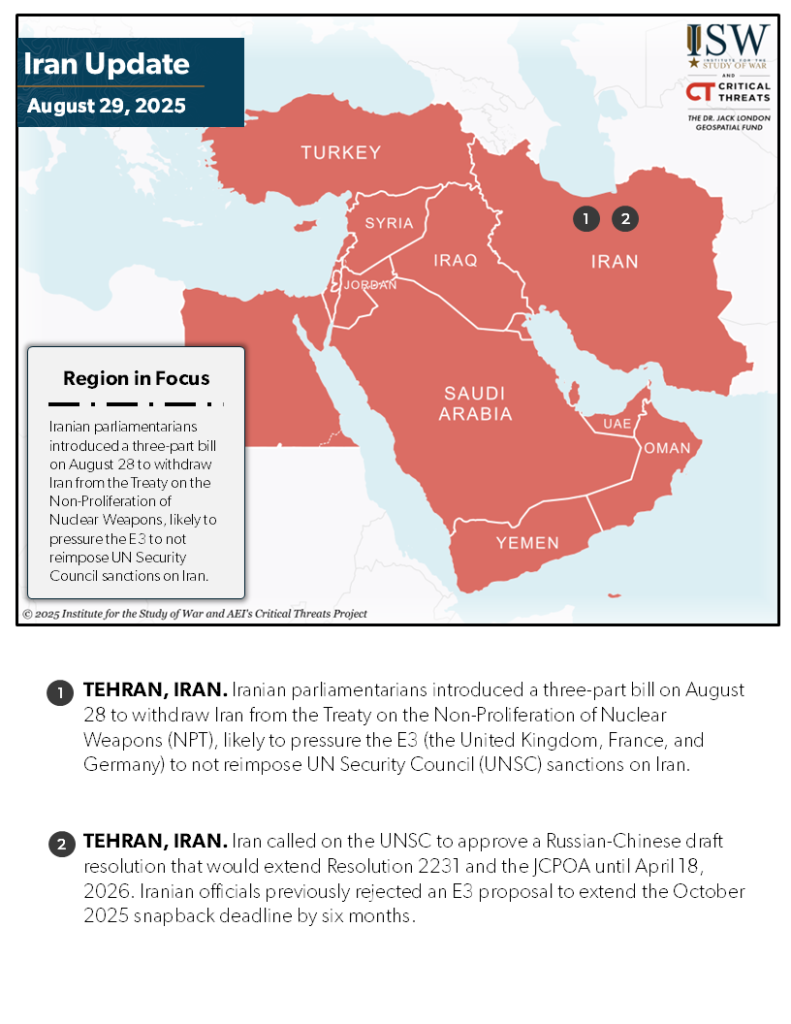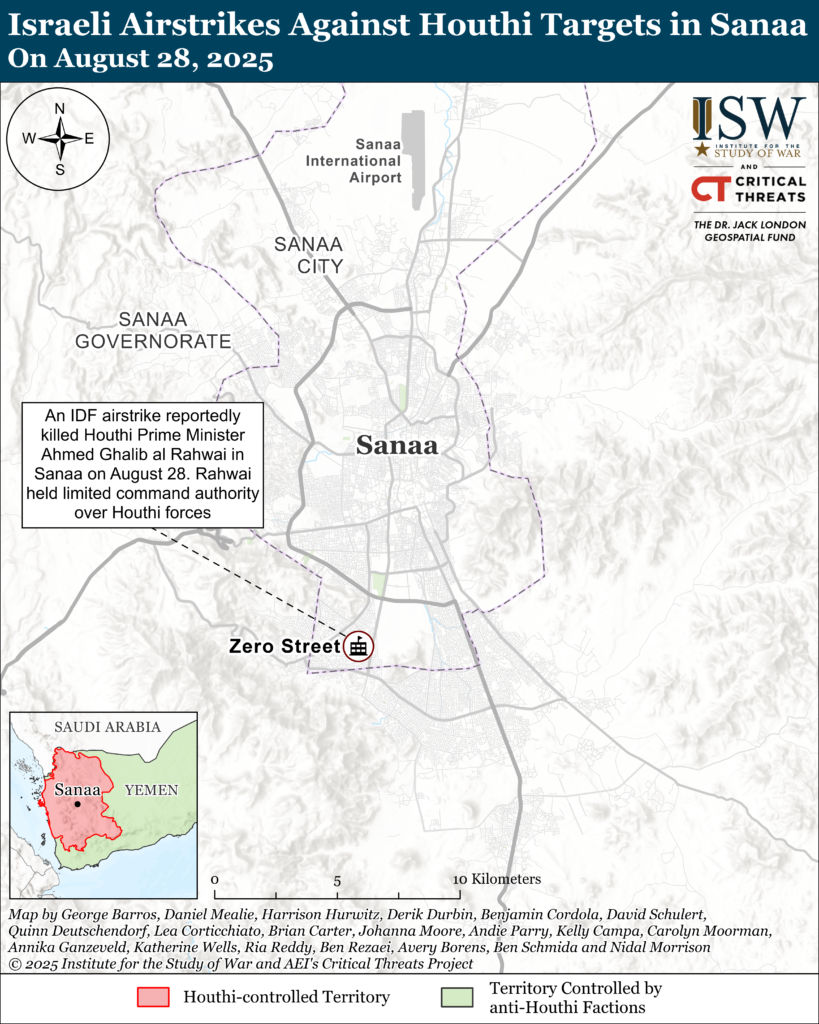Iranian parliamentarians introduced a three-part bill on August 28 to withdraw Iran from the Treaty on the Non-Proliferation of Nuclear Weapons (NPT), likely to pressure the E3 (the United Kingdom, France, and Germany) to not reimpose UN Security Council (UNSC) sanctions on Iran.[1] The bill would require Iran to leave the NPT and the Additional Protocol, end all negotiations with the United States and the E3, and terminate cooperation with the International Atomic Energy Agency (IAEA).[2] The Iranian parliament recently passed a law on June 25 that suspended Iranian cooperation with the IAEA, which makes the last clause largely performative.[3] The E3 triggered the Joint Comprehensive Plan of Action (JCPOA) snapback mechanism on August 28.[4] The JCPOA snapback mechanism allows JCPOA signatories to reimpose UNSC sanctions on Iran in the event of Iran’s “significant non-compliance” of JCPOA commitments.[5] The process to reimpose UNSC sanctions on Iran lasts 30 days, and Iran likely seeks for the E3 to reverse its decision to reimpose these sanctions during the 30-day period.
The introduction of this bill may reflect differences between various regime institutions about how the regime should respond to the E3 decision to trigger the snapback mechanism. Iranian Foreign Affairs Minister Abbas Araghchi wrote a letter to the European Union on August 29 in which he stated that Iran “remains committed” to diplomacy and is willing to resume negotiations to reach a “fair and balanced” agreement.[6] This statement contrasts with the three-part bill, which would suspend all negotiations between Iran and the United States and the E3. The difference between parliament and the executive branch’s views comes after hardline parliamentarians recently criticized the Iranian government for allowing IAEA inspectors to return to Iran. Parliamentarians claimed that the decision violated the law that parliament passed on June 25.[7] IAEA inspectors returned to Iran on August 27 to supervise a fuel replacement at the Bushehr Nuclear Power Plant. IAEA inspectors do not have access to other Iranian nuclear facilities, such as Natanz or Fordow.
Iran called on the UNSC to approve a Russian-Chinese draft resolution that would extend Resolution 2231 and the JCPOA until at least April 18, 2026.[8] The snapback mechanism is currently set to expire on October 18, 2025. Iran’s Mission to the UN said on August 28 that UNSC members face a “decisive” choice between backing the Russian–Chinese resolution and preserving diplomacy or reimposing UNSC sanctions, which it claimed would cause “grave consequences.”[9] Iran previously rejected an E3 proposal to extend the snapback deadline by six months, arguing that extending the snapback deadline gives the E3 more time to reimpose UNSC sanctions on Iran.[10] The E3 offered to extend the snapback deadline in return for Iran resuming full cooperation with the IAEA, resuming negotiations with the United States, and accounting for its 60 percent enriched uranium stockpile.[11] The Russian-Chinese resolution does not appear to include these conditions and simply urges all parties to resume negotiations, which makes this resolution much more favorable for Iran than the E3 proposal.[12] The Russian-Chinese resolution also reportedly bans the E3 from reimposing UNSC sanctions on Iran during the six-month extension period.
Key Takeaways
Iranian response to the E3’s decision to trigger the snapback mechanism: Iranian parliamentarians introduced a three-part bill on August 28 to withdraw Iran from the Treaty on the Non-Proliferation of Nuclear Weapons (NPT), likely to pressure the E3 (the United Kingdom, France, and Germany) to not reimpose UN Security Council (UNSC) sanctions on Iran.
Iranian cooperation with Russia and China to avoid snapback sanctions: Iran called on the UNSC to approve a Russian-Chinese draft resolution that would extend Resolution 2231 and the JCPOA until April 18, 2026. Iranian officials previously rejected an E3 proposal to extend the October 2025 snapback deadline by six months.
Iran
Iranian Supreme Leader Ali Khamenei’s representative to Sistan and Baluchistan Province, Ayatollah Mostafa Mahami, met with Islamic Revolutionary Guards Corps Ground Forces Quds Operational Base Commander Brigadier General Hassan Mortazavi on August 29.[13] This meeting comes after IRGC Ground Forces conducted counterterrorism operations in Iranshahr, Khash, and Saravan in Sistan and Baluchistan Province on August 27 that killed 13 Jaish al Adl fighters and an Iranian security officer.[14] Iranian security forces also seized a Jaish al Adl weapons cache in Iranshahr on August 28 that included improvised explosive device (IED) components and hand grenades. Jaish al Adl, which is a Baloch Salafi-jihadi militant group, likely intended to use this equipment to attack local security forces.[15] Jaish al Adl has increased its rate of attacks targeting Iranian security forces in southeastern Iran in recent weeks.[16]
Iraq
Iraqi National Intelligence Service Director Hamid al Shatri discussed counterterrorism, border security, and bilateral relations with Syrian President Ahmed al Shara in Damascus on August 28.[17] Shatri is reportedly affiliated with the Iranian-backed Badr Organization.[18] Kurdish media reported that Shatri and Shara also discussed the restoration of the Kirkuk-Baniyas crude oil pipeline.[19] Syria and Iraq shut down the pipeline in 2010 after it sustained damage during counterterrorism operations against the Islamic State of Iraq and Syria (ISIS).[20] Syria and Iraq agreed on August 12 to form a joint technical committee to assess the pipeline’s current status.[21] CTP-ISW previously assessed that the Syrian transitional government may seek to reopen the pipeline to compensate for lost Iranian oil exports to Syria after the fall of the Assad regime.[22] Shatri and Shara’s meeting occurred while the Special Missions Unit of the 27th Popular Mobilization Forces (PMF) Brigade, which is affiliated with the Badr Organization, deployed to the Syria-Iraq border in western Anbar Province.[23] The 27th PMF Brigade typically operates in Salah al Din Province.[24] An Iraqi Border Guard officer responsible for the al Qaim-Albu Kamal border crossing told Saudi media on August 29 that the deployment of the brigade to the border was “routine” and does not have political or security implications.[25]
Syria
Syrian President Ahmed al Shara appointed members to the National Transitional Justice Commission on August 28.[26] The 13-member commission aims to investigate former regime members, hold individuals accountable for crimes committed during the Syrian Civil War, compensate victims, and support national reconciliation.[27] Shara established the commission and appointed Abdul Basit Latif as its chairman in May 2025, but Shara did not appoint other members of the commission at the time.[28] Latif held political positions in the Free Syrian Army and the Syrian National Coalition during the civil war.[29] The appointment of members to the commission will likely enable the commission to begin its transitional justice efforts and could increase Syrian citizens’ confidence in the Syrian transitional government. Charges and convictions against individuals who committed crimes and atrocities could reduce revenge killings that target former regime members because the committee would act as a formal mechanism to achieve transitional justice. CTP-ISW recorded five revenge killings targeting former regime-affiliated individuals in Syria between August 22 and 29.[30] These killings reflect that some Syrians believe that there has been no justice for the atrocities that the Assad regime committed. The National Transitional Justice Commission could alleviate some of these grievances, but the transitional government must charge, prosecute, and sentence former Assad regime members through this commission to demonstrate its commitment to transitional justice and build trust among targeted communities.[31]
The United States eased licensing requirements for US exports to Syria on August 28.[32] The US Commerce Department’s Bureau of Industry and Security (BIS) announced that US goods and technology that have “purely civilian uses,” such as consumer communications equipment and some civil aviation-related items, can now enter Syria without an export license. The BIS will review dual-use items on a case-by-case basis and continue to restrict exports to malign actors in Syria who are still sanctioned by the United States.[33] Syrian Central Bank Governor Abdul Qadir al Hasriya said on August 29 that the Syrian Central Bank and Finance Ministry will work with the US Treasury Department to continue Syria’s integration into the international financial system.[34] The easing of export license requirements follows President Donald Trump’s June 30 executive order to end US sanctions on Syria.[35] The export of US technology and goods to Syria will help the Syrian transitional government recover from the 14-year civil war and grow Syria’s domestic civil aviation, power generation, and telecommunications industries.[36]
Arabian Peninsula
The Israel Defense Forces (IDF) killed Houthi Prime Minister Ahmed Ghalib al Rahwai in an airstrike in Haddah District, southern Sanaa City, on August 28, according to local sources.[37] Rahwai held limited authority over Houthi forces and largely had a “ceremonial” role, according to local sources.[38] A Yemeni journalist denied Israeli media reports that the airstrike also targeted and killed Houthi Chief of Staff Mohammad Abdul Karim al Ghamari and Defense Minister Mohammad Nasir al Atifi, citing an unspecified security source.[39] Anti-Houthi media claimed that IDF airstrikes in Haddah District killed and injured several other senior Houthi officials.[40] Other Yemeni outlets reported that the IDF conducted airstrikes targeting a Houthi weapons depot near the Presidential Palace complex in al Sabeen District, southern Sanaa City, and a Houthi military site in the Attan area of western Sanaa City.[41] CTP-ISW cannot independently verify the claims that IDF airstrikes targeted other Houthi officials and additional Houthi sites at the time of this writing.

 Eurasia Press & News
Eurasia Press & News



